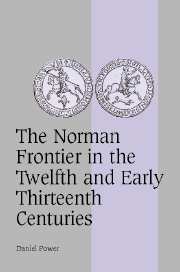Book contents
- Frontmatter
- Contents
- List of maps
- List of tables
- Preface
- Notes on names, dates, manuscripts and coinage
- Note on maps
- List of abbreviations
- Introduction
- Part I PRINCELY POWER AND THE NORMAN FRONTIER
- Chapter 1 The dukes of Normandy and the frontier regions
- Chapter 2 Capetian government in the Franco-Norman marches
- Chapter 3 The Church and the Norman frontier
- Chapter 4 The customs of Normandy and the Norman frontier
- Part II THE POLITICAL COMMUNITIES OF THE NORMAN FRONTIER
- Part III THE POLITICAL DEVELOPMENT OF THE NORMAN FRONTIER
- Conclusion
- Appendix I Genealogies
- Appendix II The campaigns in eastern Normandy (1202)
- Bibliography
- Index
Chapter 3 - The Church and the Norman frontier
Published online by Cambridge University Press: 22 September 2009
- Frontmatter
- Contents
- List of maps
- List of tables
- Preface
- Notes on names, dates, manuscripts and coinage
- Note on maps
- List of abbreviations
- Introduction
- Part I PRINCELY POWER AND THE NORMAN FRONTIER
- Chapter 1 The dukes of Normandy and the frontier regions
- Chapter 2 Capetian government in the Franco-Norman marches
- Chapter 3 The Church and the Norman frontier
- Chapter 4 The customs of Normandy and the Norman frontier
- Part II THE POLITICAL COMMUNITIES OF THE NORMAN FRONTIER
- Part III THE POLITICAL DEVELOPMENT OF THE NORMAN FRONTIER
- Conclusion
- Appendix I Genealogies
- Appendix II The campaigns in eastern Normandy (1202)
- Bibliography
- Index
Summary
One of the striking features of the duchy of Normandy was its similarity in territorial extent to the metropolitan province of Rouen. Before the year 1000 the area under ducal rule corresponded remarkably closely to the ecclesiastical province, which was in turn descended from the Roman province of Lugdunensis Secunda. The idea of Normandy as seven dioceses was so powerful that Rigord summed up the Capetian subjugation of the province as the surrender of the civitates of Coutances, Bayeux, Lisieux and Avranches, adding that the civitates of Evreux and Sées were already in King Philip's hands. Of all Normandy, the monk of Saint-Denis wrote, nothing now remained except for the civitas of Rouen and the oppida of Verneuil and Arques.
The importance of the Norman Church for the duchy went much further than mere territorial resemblance: it also formed one of the main planks of ducal power. One of the chief means by which the early rulers of the Normans had expanded and consolidated their authority had been to establish their control over the bishoprics of the region. There was some resistance, of course, and it was not until the mid-eleventh century that the dukes wrested control of the bishopric of Sées from the lords of Bellême. Another method which the dukes had used to consolidate their power was the founding, refounding or patronising of monasteries within their territory.
- Type
- Chapter
- Information
- Publisher: Cambridge University PressPrint publication year: 2004



